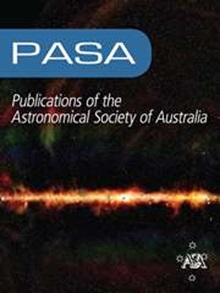天体的全局结构:克努森数的影响
IF 4.6
3区 物理与天体物理
Q1 ASTRONOMY & ASTROPHYSICS
Publications of the Astronomical Society of Australia
Pub Date : 2024-07-11
DOI:10.1017/pasa.2024.44
引用次数: 0
摘要
恒星风与部分电离的局部星际介质(LISM)之间的相互作用在天体物理学中十分常见。然而,描述中性成分的主要困难在于星际原子的平均自由路径 l 可能与天体球的特征尺寸 L 相当(即克努森数等于 l/L,近似等于 1,如日光层的情况)。在这种情况下,单流体近似变得无效,必须对中性成分使用动力学描述。在这项研究中,我们考虑了一个普通的天体,并使用动力学-气体动力学模型来研究天体的全局结构如何取决于克努森数。我们给出的数值结果涵盖了极宽的努森数范围(从 0.0001 到 100)。此外,我们还探索了单流体方法对各种尺寸天体的建模适用性。我们在模型中排除了星际磁场和恒星磁场的影响,以便对动力学效应进行可行的参数研究。这项工作的主要结论是,对于大型天体(与弓形冲击波的距离大于 600 AU),在靠近天体顶点的外部冲击层中会形成一个受热的稀薄等离子体层。该层的形成与原子(特别是ENAs)对等离子体的局部加热有关,这些原子在天体休止符后再次进行电荷交换。这一过程极大地改变了外部冲击层的流动结构和弓形冲击的位置,无法用单一流体模型来描述。此外,本文还讨论了原子如何在近对流层条件下削弱弓形冲击。本文章由计算机程序翻译,如有差异,请以英文原文为准。
The global structure of astrospheres: effect of Knudsen number
The interaction between stellar winds and the partially ionized local interstellar medium (LISM) is quite common in astrophysics. However, the main difficulty in describing the neutral components lies in the fact that the mean free path of an interstellar atom, l, can be comparable to the characteristic size of an astrosphere, L (i.e., the Knudsen number, which is equal to l/L, is approximately equal to 1, as in the case of the heliosphere). In such cases, a single-fluid approximation becomes invalid, and a kinetic description must be used for the neutral component. In this study, we consider a general astrosphere and use a kinetic-gas dynamics model to investigate how the global structure of the astrosphere depends on the Knudsen number. We present numerical results covering an extremely wide range of Knudsen numbers (from 0.0001 to 100). Additionally, we explore the applicability of single-fluid approaches for modeling astrospheres of various sizes. We have excluded the influence of interstellar and stellar magnetic fields in our model to make parametric study of the kinetic effects feasible. The main conclusion of this work is that, for large astrospheres (with a distance to the bow shock greater than 600 AU) a heated rarefied plasma layer forms in the outer shock layer near the astropause. The formation of this layer is linked to localized heating of the plasma by atoms (specifically, ENAs) that undergo charge exchange again behind the astropause. This process significantly alters the flow structure in the outer shock layer and the location of the bow shock, and it cannot be described by a single-fluid model. Additionally, this paper discusses how atoms weaken the bow shocks at near-heliospheric conditions.
求助全文
通过发布文献求助,成功后即可免费获取论文全文。
去求助
来源期刊
CiteScore
5.90
自引率
9.50%
发文量
41
审稿时长
>12 weeks
期刊介绍:
Publications of the Astronomical Society of Australia (PASA) publishes new and significant research in astronomy and astrophysics. PASA covers a wide range of topics within astronomy, including multi-wavelength observations, theoretical modelling, computational astronomy and visualisation. PASA also maintains its heritage of publishing results on southern hemisphere astronomy and on astronomy with Australian facilities.
PASA publishes research papers, review papers and special series on topical issues, making use of expert international reviewers and an experienced Editorial Board. As an electronic-only journal, PASA publishes paper by paper, ensuring a rapid publication rate. There are no page charges. PASA''s Editorial Board approve a certain number of papers per year to be published Open Access without a publication fee.

 求助内容:
求助内容: 应助结果提醒方式:
应助结果提醒方式:


